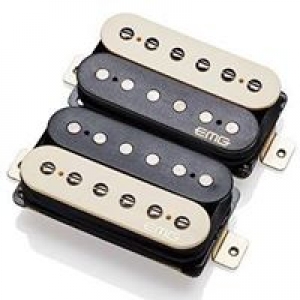
String Interface & Magnet
The first consideration in pickup design is the string interface. The
selection of a bar magnet or individual pole pieces is an important
one. All early EMG designs used a bar magnet for two reasons. First,
pole pieces place too much magnetism under the strings and cause
lower ones to go “out of pitch” with a Doppler effect. And second,
pole pieces can also make intonation and tuning difficult. Designs
featuring a bar magnet have a much more linear (balanced) output
from string to string. Their attack is less pronounced than the pole
piece design, resulting in smoother distortion, less fade on string
bending, and much better sustain.
By relying on the internal preamp for gain, the bar magnet can be
smaller, further limiting the magnetic “pull” on the strings. The
inherent qualities of a bar magnet allow a continuous magnetic field
that allows for any string spacing which is perfect for use with any
multi-stringed instrument. On the other hand, if you prefer pole
pieces, there is an EMG model to meet your needs. Pole pieces impart
a much more percussive attack giving the pickup more of an “organic”
sound. Depending on the model, steel pole pieces (either bar or
screw/stud), can be coupled with alnico or ceramic magnets, each
combination having individual characteristics that affect the attack,
output, frequency response and ultimately the tone of the pickup.
Noise Reduction & Low Impedance
Another benefit from the internal preamp is noise reduction. By
integrating the preamp into the housing, all the elements of the
pickup can be shielded. By matching the coils to a high degree
through “impedance modeling”, the low frequency hum and buzz are
virtually eliminated while making the sound more vibrantly alive. In
addition, each EMG is housed in a composite or stainless steel cover
cap that eliminates all other forms of interference.
Most EMG pickup models have noise figures better than –85dB, still
other EMG pickups achieve a noise figure that exceeds –100dB. The
low impedance output of the EMG internal preamp provides other
great features. You can run a cable for up to 100 feet (30 meters)
without losing high frequency response. You’ll get the same tone
with a wireless unit as you do with a cable, and the tone of your
instrument will remain consistent through volume changes. Low
impedance also means that not only can you plug directly into your
favorite amp, you can go direct to a tape preamp (especially useful
for acoustic guitar recording) or mixing console input without a
direct box. EMG pickups are so quiet you don’t even need to ground
the strings of the instrument
Tone Modeling / Coils / Pre-Amp
Each active EMG pickup has two coils and they are the basis of the
pickup’s design. There are different types and sizes of magnet wire
that can be used, and combining their attributes with the size and
shape of the coil has a tremendous effect on the tone. The dualcoil setup is necessary for noise reduction and is a key to providing
the distinctive EMG tone. The preamplifier used inside each active
EMG pickup is no ordinary preamp. Built directly into each pickup,
the preamp is an integral part of the pickup design ensuring quality
of sound performance, incredible noise reduction, and simplicity in
Tone Modeling / Coils / Preamp
installation. A natural by-product of the preamp is gain. It allows us
to design a pickup for its particular tone without concern for the
pickup’s output. EMG pickups use “tone modeling” to manipulate the
two coils. This innovation allows us to shape a mix of the reactive
slope and resonance from each of the two coils. The idea is to achieve
a complex mixture of each coil’s phase and frequency response
resulting in a richer overall tone. After the coils are modeled, any
amount of output needed is provided by the preamp.
"EMG Inc" - Social Networks
Do you own or manage this business?
Click here to claim the EMG Inc listing and add social networks, logos, descriptions and more.
